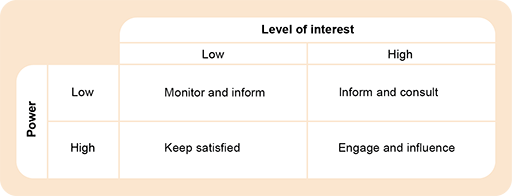3 Working with stakeholders

Working with stakeholders can be a complicated process. As noted earlier, stakeholders can have competing perspectives on a voluntary organisation’s mission or how it does things, and it can be difficult to negotiate the differing levels of power and interest.
You can use the matrix in Figure 4 to think about possible strategies on how to work with stakeholders: this is depicted in Figure 6.

Looking at the boxes now, you can start to think about methods of engagement:
- High power – high interest people must be fully engaged. This group is the one that organisations will work with closely.
- High power – low interest people need to be involved.
- Low power people with a high interest need to be kept well informed and consulted.
- People with low levels of power and less interest should be monitored but they may not want to become heavily involved in the organisation’s work.
Stakeholder theorists have identified a number of ways to manage the sometimes competing perspectives and interests of organisational stakeholders. Some of these strategies, identified by Mistry (2007), include:
- Addressing certain stakeholder perspectives adequately rather than in the best possible way (what is often termed ‘satisficing’, a blending of the words ‘satisfy’ and ‘suffice’).
- Addressing stakeholder issues over a period of time – rather than right away – in order to conserve resources (called ‘sequencing’).
- Balancing the needs of one stakeholder group with another’s so that both achieve at least partial success (what are known as ‘trade-offs’).
Managers and executives in the voluntary sector will often take a relative approach to dealing with stakeholders. Those who are the most crucial will receive the most attention, and as Emma De Vita stated in the extract you read earlier, ‘Keep the most important people (those with the money) happy and placate the rest with free pens and newsletters’ (2007). In the sometimes chaotic environment of the voluntary sector, an organisation may not have the time, staff or resources to pursue anything but this type of strategy.
However, other theorists argue that to focus on the needs of only the most powerful stakeholders is a poor strategy for overall effectiveness. In the business world, this means that business organisations need to focus on not only ‘creating value’ for their shareholders but also for other stakeholders (e.g. their employees and the community). In the context of the voluntary sector, where external stakeholders can play a much more powerful role, the organisation must balance the needs of its different stakeholder groups with the ability to address these needs amidst a scarcity of resources.
